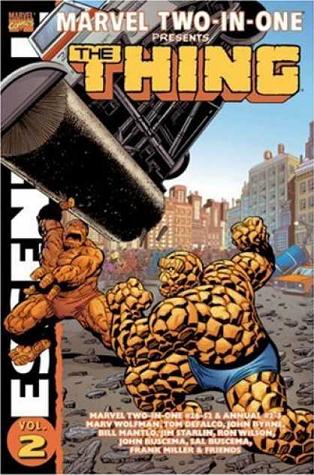
Marvel Two-in-One Vol. 2
Marv Wolfman, Roger Slifer, Ron Wilson and friends
Reprints: Marvel Two-in-One #26-52, Annual #2-3 (April 1977 – June 1979)
Get this for: the occasional gems in the mire — two stars
They can’t all be winners. The Essentials phonebooks are a great way to get your hands on large chunks of classic Marvel comics, but you have to accept the occasional dud. Marvel is after all fairly indiscriminating in their approach to the line: everything that might be commercially interesting gets at least one volume and if it sells, more volumes follow. Some of the series collected were never to great to begin with; because these volumes are published in strict chronological order and every series has its up and downs, even good series will have weaker volumes every now and again. In the case of Essential Marvel Two-in-One Vol. 2, the original series was never a priority for the top writers or artists at Marvel, so large stretches of it are mediocre at best.
Marvel Two-in-One, like its companion title Marvel Team-Up suffers from two flaws: it’s format, which requires another guest star each month and the fact that it play’s second fiddle to another series, in this case The Fantastic Four, in Team-up‘s case Amazing Spider-Man. Which means you cannot change the status quo in this series, anything that does change has to be put right in the end and whatever happens in the main title will end up determining events here as well. In general then, coming up with a story that’s “good enough” will do. The same goes for the art: people will buy the issue depending on the guest star anyway, so why knock yourself out? A bit cynical perhaps, but the truth is that Marvel Two-in-One and Marvel Team-Up never helped a writer or artist to make their reputation.
Roughly half the stories in this volume were written by Marv Wolfman, who does try to give some semblance of continuity to the series, with issue 26 to 36 forming one long sequence of stories. The Thing gets involved with SHIELD against Mentallo and the Fixer, mixes it up with Deathlok, then has to fly to England to find an expert to help Deathlok regain his independence, crosses the path of HYDRA and Spider-Woman, tangles with Shang-Chi, Master of Kung Fu, teams up with minor mystic hero Modred, not to mention Nighthawk, then spends two issues cleaning up the plotlines left over from the cancellation of Skull the Slayer, coincidently one Wolfman co-created. This could’ve worked well, but unfortunately it all turned out fairly dreary, things not helped by the cor blimey stow the crows mockney Wolfman insists all English characters speak with.
The next writer up, Roger Slifer, continues Wolfman’s approach to the title with a multi-issue story about the Thing being framed for assault and criminal damage, followed by a two issue teamup with Black Panther and Brother Voodoo against a zombie (pardon, “zuvembi”, zombies not allowed by the Comics Code yet), neither of which are great successes. A curious detail of the second stoy is that it features Idi Amin, then still the dictator of Uganda, as the villain behind the “zuvembi” turned out to be the Ugandan minister of economics who was once a supervillain called Dr. Spectrum (don’t ask). Now cameos by actually existing politicians are nothing new in comics (as witnessed by the appearance by Jimmy Carter — or at least the Impossible Man masquerading as him — in this volume as well) but to have Idi Amin is a bit tasteless.
The remainder of the stories here are less ambitious, just simple one issue teamups and nothing interesting. However, amongst all this dross are a few absolute gems. The first is the second part of the Jim Starlin written and pencilled story from Avengers Annual #7 and Marvel Two-in-One Annual #2, annoyingly incomplete as the first part is omitted, but still great on its own. Then there’s #50, a Byrne special, in which the Thing travels back in time to the days just after the Fantastic Four had formed, to try and cure his past self when it’s no longer possible for himself to be cured. Finally, the very next issue has a Peter Gillis (a very underrated writer), Frank Miller story featuring a bunch of seventies Avengers (Ms. Marvel, Best, Wonderman) as well Nick Fury against the power of the Yellow Claw’s Sky Claw, hijacked by a mad American general wanting to take over the government.
The Byrne, Starlin and Miller issues standout not just for the stories, but especially for their art. For the most part the art here was in the hands of Ron Wilson, who can be best described with “adequate”, or similar artists like Bob Hall or Alan Kupperberg. Having somebody like Byrne or Starlin do an issue is like coming to an oasis in a desert of mediocricy. But the best art this volume is from Frank Miller, who goes for the Steranko look for his story.
So there you have it. Essential Marvel Two-in-One Vol. 2 is a collection with little to recommend itself, save for the three exceptions noted above, unless you’re a huge Thing fan or collect appearances by some of the more obscure heroes seen here.